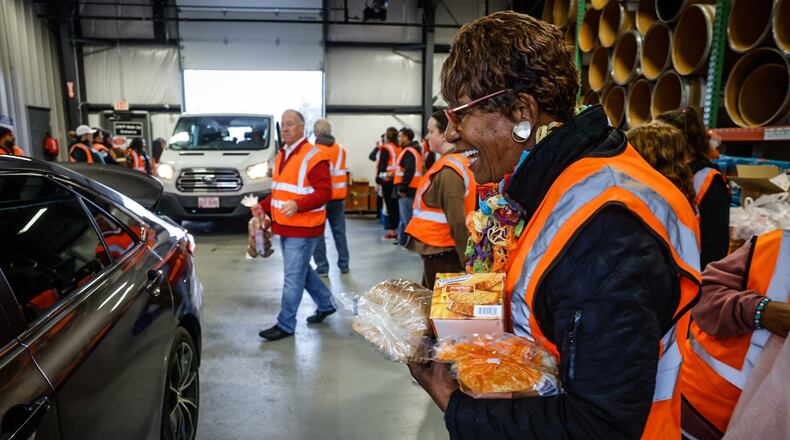“These people are very grateful ... to the point that some of them even cry,” said Linda Nervis, who volunteered at Thursday’s food distribution with her colleagues from a local State Farm agency. “When you put that stuff in the car and they tell you thank you, you know that they mean it.”
Some cars were driven by younger folks who then delivered the food to designated seniors, some were driven by the seniors themselves, and a number of cars were also carrying children, whose eyes lit up when they were handed a surprise candy treat by a volunteer.
Nearly 1 in 4 children are food insecure in the Dayton area — meaning their home has limited or uncertain access to adequate food — according to 2020 data from The Foodbank, the most recent data available.
The rate of food insecurity for the entire population is estimated at 14.2% in Montgomery County, 11.1% in Greene County and 11.3% in Preble County. For adults who are parents, this rate may be even higher than reported, local experts say, a staggering reality that can be considered a root cause for many additional social, emotional, and physical health conditions.
“Parents will go without food so they can feed their children, so what they do is substitute with cheaper foods, they eat less, and while it may be a lot of calories, it’s not nutritious and this leads to obesity, diabetes, heart disease, stroke, you name it,” said former Congressman and creator of the Hall Hunger Initiative Tony Hall.
Causes of food insecurity
Hunger in America is largely a result of poverty, says Hall. Last year, about 27.6% of Dayton residents lived in poverty, according to data from the 2021 American Community Survey analyzed by the Dayton Daily News. This struggle is compounded by rising inflation rates, higher rent prices, and inflated energy costs in many areas.
“Poverty is many things: it’s low pay, high rent, expensive healthcare, gas and heating, anything,” Hall said. “The price of food is not the only problem, but they don’t allow you to pay half your rent and you can’t pay for just half of the gas you need to get to work, so food is where the people cut back.”
According to Lauren Tappel, The Foodbank Inc.’s development and marketing manager, if a family does not have consistent access to affordable, healthy food options, that indicates food insecurity.
“This can vary widely; someone may be able to afford enough food to feed their family, but that food may be highly processed, and therefore cheaper, but have little nutritional value,” Tappel said. “And there are some who struggle to consistently afford those foods, as well.”
As Dayton’s only food bank, The Foodbank works closely with partner agencies throughout the region to distribute food and fight against hunger. Throughout fiscal year 2022, The Foodbank Inc. alone served 24,384 households through its on-site drive-thru service, distributing over 1.3 million pounds of food to 69,000 individuals.
Additionally, with the help of hundreds of volunteers, The Foodbank served more than 200,000 households — more than half a million individuals — through food pantry, pop-up drive-thru, and e-pantry services in 2022.
‘I realized there is help’
Hall said it’s also important to consider racial disparity when analyzing food insecurity in the Dayton region.
“Black and Hispanic families are twice as likely to experience hunger than white people in Dayton, and food deserts are more likely to be in Black communities,” he said.
For instance, in Trotwood, a city whose population is nearly 65% Black, residents often travel to Kroger and Meijer in Englewood to purchase food, but this option isn’t as realistic for those without cars. Earlier this year, the Dollar General at 5118 Salem Ave. closed, which added to the already apparent food desert in the area. Main Street Food Market opened in April, but there are still gaps to be filled.
Deondra Porter, of Xenia, has volunteered with The Foodbank for three years. After a brief stint in the hospital last year due to complications from COVID-19, Porter said her passion for volunteer work had grown exponentially.
“My motivation was to see other people happy,” she said. “I was in the hospital for three days and on oxygen for nine weeks, and I honestly slipped into a depression. (The Foodbank) let me volunteer while I was still on oxygen ... I just wanted to help.”
Porter has a unique vantage point of this volunteer work, as she has also been on the receiving end.
“I’ve been out of work for two years, so I’ll get up early, come help with the (drive-thru) lines and pass out food, then get my food,” she said. “Everybody who comes through this line has a story ... I used to be scared, but I realized there is help out there and that’s the motto: No person hungry should be left behind.”
How to help
For more than 40 years, our readers have opened their hearts and wallets to support Valley Food Relief, which raises money for The Foodbank, Inc. Please join us this year in helping The Foodbank feed families, children and seniors. You can make your gift here.
About the Author
